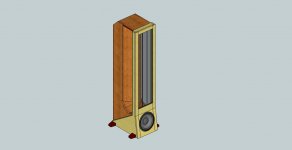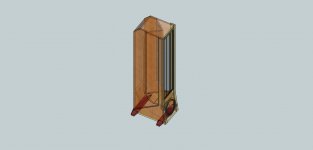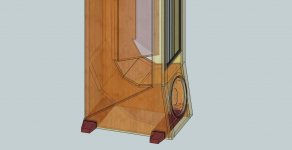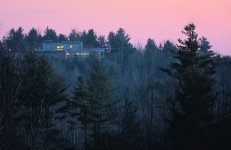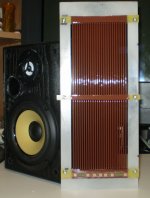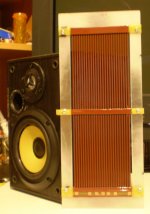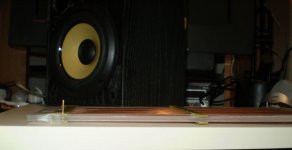I'm refining my ESL speaker design...
The original beam-splitter design was drawn in DeltaCad 2D and is insanely complex and time-consuming to build. Since I've gotten a some requests for drawings on my blog page (Jazzman's DIY Electrostatic Loudspeaker Page), I've decided to modify the design to make it easier to build and also render it in 3D. So last week I downloaded Google Sketchup and started the learning process (old dogs don't learn new tricks so good).
The new version is an inch slimmer, the 5mm plywood sheathing and edge trim on the woofer box are gone, replaced with just a painted MDF woofer box, or can substitute 3/4 A-A plywood if a wood finish is desired. The frame sides and woofer baffle are 3/4 red oak A-A plywood and the front panel frame is solid red oak wood.
The transmission line is now 6 inches longer, and the angles on the beam-splitter now form a sharper blade @ 50 degrees incident to the panel (was 45), such that the rearward sound striking the beam splitter is deflected 5 degrees rearward of perpendicular. I think the slimmer version is more esthetically pleasing from a frontal view and many fewer pieces and glue ups should reduce the build time by at least 1/3.
I used an Aurum Cantus Mk II woofer originally but I would like to try out its ultra-low Q big brother: AC250/75C2C
OK... the rap on really low Q woofers is their stiffer suspension rolls off the low end so you need to EQ them and feed them more power to play really low. I get that, but their lower Q also means they have less overshoot in the midbass to better match the [near-zero-Q] electrostat. Besides, I'm using subs for the heavy lifting on the low end anyhow
Since my original speakers are playing fine and still sound fantastic, and money is an issue for me (ex-wives), I can't justify building a pair of the new version for myself, but at least I can now post an easier, sexier design (in 3D) on my blogpage, for anyone interested. What can I say... designing speakers is a damnable psychosis.
Here's what I've drawn up so far:
The original beam-splitter design was drawn in DeltaCad 2D and is insanely complex and time-consuming to build. Since I've gotten a some requests for drawings on my blog page (Jazzman's DIY Electrostatic Loudspeaker Page), I've decided to modify the design to make it easier to build and also render it in 3D. So last week I downloaded Google Sketchup and started the learning process (old dogs don't learn new tricks so good).
The new version is an inch slimmer, the 5mm plywood sheathing and edge trim on the woofer box are gone, replaced with just a painted MDF woofer box, or can substitute 3/4 A-A plywood if a wood finish is desired. The frame sides and woofer baffle are 3/4 red oak A-A plywood and the front panel frame is solid red oak wood.
The transmission line is now 6 inches longer, and the angles on the beam-splitter now form a sharper blade @ 50 degrees incident to the panel (was 45), such that the rearward sound striking the beam splitter is deflected 5 degrees rearward of perpendicular. I think the slimmer version is more esthetically pleasing from a frontal view and many fewer pieces and glue ups should reduce the build time by at least 1/3.
I used an Aurum Cantus Mk II woofer originally but I would like to try out its ultra-low Q big brother: AC250/75C2C
OK... the rap on really low Q woofers is their stiffer suspension rolls off the low end so you need to EQ them and feed them more power to play really low. I get that, but their lower Q also means they have less overshoot in the midbass to better match the [near-zero-Q] electrostat. Besides, I'm using subs for the heavy lifting on the low end anyhow
Since my original speakers are playing fine and still sound fantastic, and money is an issue for me (ex-wives), I can't justify building a pair of the new version for myself, but at least I can now post an easier, sexier design (in 3D) on my blogpage, for anyone interested. What can I say... designing speakers is a damnable psychosis.
Here's what I've drawn up so far:
Attachments
Very cool Charlie !!
You can try modeling the difference between the two drivers using this software from a fellow DIY'er,
http://www.diyaudio.com/forums/soft...sion-line-modelling-software.html#post3179499
He did a very nice job on it and many of the experts in the field of TL's say that it is pretty accurate for the most part.
I have been playing with it alot trying to get a decent design for a more compact version using my 8" subs as they have a fairly low Q as well.
I have found the there is no substitute for the low end extension and the length of the Transmission line.
My 8's have about 50% more excursion capability than the Aurum's but they are smaller.
I would like to use at least two of my drivers in one if not three but there is no provision in the program for multiple driver's as of yet.
I will ask him on his thread sometime how to go about this.
Give it a try sometime and let me know what you find.
Cheers !!!
jer
You can try modeling the difference between the two drivers using this software from a fellow DIY'er,
http://www.diyaudio.com/forums/soft...sion-line-modelling-software.html#post3179499
He did a very nice job on it and many of the experts in the field of TL's say that it is pretty accurate for the most part.
I have been playing with it alot trying to get a decent design for a more compact version using my 8" subs as they have a fairly low Q as well.
I have found the there is no substitute for the low end extension and the length of the Transmission line.
My 8's have about 50% more excursion capability than the Aurum's but they are smaller.
I would like to use at least two of my drivers in one if not three but there is no provision in the program for multiple driver's as of yet.
I will ask him on his thread sometime how to go about this.
Give it a try sometime and let me know what you find.
Cheers !!!
jer
Hi Charlie,
Beautiful work, as usual. Here's a thought on the off chance it's useful. I'm unsure of the dimensions in your drawings so I'll say at the outset that I may be off base.
That said, have you thought about the wavelengths reproduced by the woofer, especially after it's been low-pass filtered by the transmission line, compared to the dimensions of some of the contours of that line? If you're really emphasizing simplicity of construction, you might consider accepting less smooth curves in your transmission line. It could simplify construction considerably, and if the T-line output is going to be limited to a couple hundred Hz and lower, I don't think dimensions on the order of inches will matter much. In other words, you could substitute right angles, or at least 45 degree angles, where you now have (admittedly more graceful looking) segmented curves. The wavelength at 300 Hz is over 1 meter so breaking bends into curves made of pieces a few inches long may not yield audible benefits.
Just a thought; feel free to disregard it if it's not useful.
Few
Beautiful work, as usual. Here's a thought on the off chance it's useful. I'm unsure of the dimensions in your drawings so I'll say at the outset that I may be off base.
That said, have you thought about the wavelengths reproduced by the woofer, especially after it's been low-pass filtered by the transmission line, compared to the dimensions of some of the contours of that line? If you're really emphasizing simplicity of construction, you might consider accepting less smooth curves in your transmission line. It could simplify construction considerably, and if the T-line output is going to be limited to a couple hundred Hz and lower, I don't think dimensions on the order of inches will matter much. In other words, you could substitute right angles, or at least 45 degree angles, where you now have (admittedly more graceful looking) segmented curves. The wavelength at 300 Hz is over 1 meter so breaking bends into curves made of pieces a few inches long may not yield audible benefits.
Just a thought; feel free to disregard it if it's not useful.
Few
Hi Few,
I struggled a bit deciding how much simpler to make cabinet, and I'm sure you're right that the internal angles need not approximate curved surfaces to the extent that I made them. The new version is simpler by virtue of fewer components and no glued on sheathing, yet still retains the angled woofer and pseudo-curved surfaces behind the woofer, which I find appealing (even if not needed). The angle cuts are not really a problem if done with an accurate table saw. Obviously, this isn't a speaker you can build in a weekend with just a circular saw!
I pretty much followed Sanders' Cookbook guidelines for the TL (not smart enough to model the damn thing mathematically) and I like how he did the compact line in his Eros speakers. And I became wedded to the idea of approximating curved surfaces immediately behind the woofer, so as to mitigate any standing waves that might rebound to the woofer. In any case, the configuration gives a quite seamless blend between the woofer and stat panel... actually astoundingly better than had I anticipated. Even though I can't really afford to, I'm not sure I can resist building a pair of this new version.
There is still much room to simplify and I will probably draw up yet another version, retaining the beam-splitter and TL but more focused on simplifying the build... with a straight front baffle/frame (verses the current version where the woofer is angled upward 8 degrees).
Hey, I'm still waiting to see those wire-stator ESL's you've been working on!
Jazz
I struggled a bit deciding how much simpler to make cabinet, and I'm sure you're right that the internal angles need not approximate curved surfaces to the extent that I made them. The new version is simpler by virtue of fewer components and no glued on sheathing, yet still retains the angled woofer and pseudo-curved surfaces behind the woofer, which I find appealing (even if not needed). The angle cuts are not really a problem if done with an accurate table saw. Obviously, this isn't a speaker you can build in a weekend with just a circular saw!
I pretty much followed Sanders' Cookbook guidelines for the TL (not smart enough to model the damn thing mathematically) and I like how he did the compact line in his Eros speakers. And I became wedded to the idea of approximating curved surfaces immediately behind the woofer, so as to mitigate any standing waves that might rebound to the woofer. In any case, the configuration gives a quite seamless blend between the woofer and stat panel... actually astoundingly better than had I anticipated. Even though I can't really afford to, I'm not sure I can resist building a pair of this new version.
There is still much room to simplify and I will probably draw up yet another version, retaining the beam-splitter and TL but more focused on simplifying the build... with a straight front baffle/frame (verses the current version where the woofer is angled upward 8 degrees).
Hey, I'm still waiting to see those wire-stator ESL's you've been working on!
Jazz
Last edited:
Hi Few,
Hey, I'm still waiting to see those wire-stator ESL's you've been working on!
Jazz
Few,
A thought occurred to me while pondering wire stators. I've read about segmented wire stators configured with inline resistors such that the center wires drive the treble and the outer wires drive progressively lower frequencies... in order to give wider dispersion and a wider sweet spot. I think it would be cool to make the setup switchable so you could just flip a switch turn the segmentation on and off. OFF for big-time slam when listening solo from the focal point, or ON when you have company over and want a wider sweet spot. Probably someone has already done that?? Just wondering...
It sounds like you have good reasons for your approach and since I won't be the one footing the bill, I selfishly hope you do build the new set---just so I can enjoy seeing the result.
The wire stator ESLs have been on hold---in fact LOTS of stuff has been on hold---while my wife and I finish up the new house we had built (photo below). I'm now painting the shop so I'm getting close to being back up an at 'em. In fact, I picked up an old used metal working lathe and a mill-drill to expand my capabilities.
In the meantime I've been slowly working through planar magnetic midrange-tweeter designs because I think my ESL panels may be too large when joined by the vertical array of woofers. I haven't abandoned the ESLs, though. They're carefully packed and I walk by them every day I go through the garage. They remind me that there is yet another project that I have started and haven't yet finished!
I haven't seen an implementation of the selectable segmentation of the sort you described. I had a thought that's a variation on that, but have never pursued it. Some complain that singers end up sounding larger than life when reproduced through large panels. I wondered whether it might be possible to have a selectable effective panel size in the vertical direction so that the listener could control the perceived image size. I think some sort of delay or at least low-pass filtering would be necessary. Probably something along the lines of the Quad ESL 63 but only along the vertical axis (unless you're simultaneously trying to broaden the horizontal distribution of high frequencies as well).
Few
The wire stator ESLs have been on hold---in fact LOTS of stuff has been on hold---while my wife and I finish up the new house we had built (photo below). I'm now painting the shop so I'm getting close to being back up an at 'em. In fact, I picked up an old used metal working lathe and a mill-drill to expand my capabilities.
In the meantime I've been slowly working through planar magnetic midrange-tweeter designs because I think my ESL panels may be too large when joined by the vertical array of woofers. I haven't abandoned the ESLs, though. They're carefully packed and I walk by them every day I go through the garage. They remind me that there is yet another project that I have started and haven't yet finished!
I haven't seen an implementation of the selectable segmentation of the sort you described. I had a thought that's a variation on that, but have never pursued it. Some complain that singers end up sounding larger than life when reproduced through large panels. I wondered whether it might be possible to have a selectable effective panel size in the vertical direction so that the listener could control the perceived image size. I think some sort of delay or at least low-pass filtering would be necessary. Probably something along the lines of the Quad ESL 63 but only along the vertical axis (unless you're simultaneously trying to broaden the horizontal distribution of high frequencies as well).
Few
Attachments
Hi CharlieM.
Since equalization is in the mix and since you will be crossing over from the panels to the woofer section high enough probably, have you considered an open baffle type of implementation for the woofers? Wouldn't it be desirable to have the dipole characteristic down to where the subwoofers take over?
Since equalization is in the mix and since you will be crossing over from the panels to the woofer section high enough probably, have you considered an open baffle type of implementation for the woofers? Wouldn't it be desirable to have the dipole characteristic down to where the subwoofers take over?
Hi CharlieM.
Since equalization is in the mix and since you will be crossing over from the panels to the woofer section high enough probably, have you considered an open baffle type of implementation for the woofers? Wouldn't it be desirable to have the dipole characteristic down to where the subwoofers take over?
I have to agree with you in as much as I think the best sonic arrangement would be a tall line source array of high-quality OB woofers next to a tall line source electrostat, like the ML Statements ($$$). And if cost and floor space and physical size were not issues for me, I might have gone that route. There are many good designs and I think mine offer a pretty good compromise between cost, size, esthetics, and performance. I have to confess though, the TL cabinets were a bitch to build.
I think you can still get seamless blending between the panel and a TL loaded woofer-- although over a more limited listening area. As the panel behaves as a line source and the woofer a point source, they can only be adjusted to balance over a small spatial area. Basically, you can aim the panels and adjust the woofer/panel outputs to achieve precise balance at the focal sweet spot (only). Moving out of their narrow sweet spot the panel/woofer become progressively unbalanced. Funny thing though-- if you get far enough out of the sweet spot, approximate balance returns.
One more consideration: Flat panel electrostats like mine give magnificent slam and imaging at the expense of constricting the sweet spot to a miniscule size. On the other hand, curved panels (like ML's) give a much wider sweet spot at the expense of less slam and less precise imaging. I figure if you go with flat panels the good listening position is only about 2 square feet in size anyway, and that's where you're going to sit, so you really haven't gained or lost much by going with or not going with a line source array of OB woofers.
The same case could not be made for curved or segmented panels, however, in which case the OB woofers would balance with the panel basically everywhere within a much wider listening area and at any distance.
Last edited:
Hi Charlie,
Have you done a comparison of flat vs. curved panels when it comes to "slam?" My experience when building flat panels was consistent with your description: the transients were reproduced in ways that reminded me of horns. Rim shots are real shots, not rounded, blurred semblances of something brief.
I've heard Martin-Logan speakers in show rooms but there were so many variables I wasn't ready to draw conclusions. Have you found that flat vs. curved really determines the amount of "slam-iness?" I wonder what this implies when considering narrower planar-magnetic (magnetostatic---whatever you want to call them) drivers.
MANY years ago a demo of Apogee Duettas was embedded in my memory as one of the very few audio experiences that redefined what audio reproduction is capable of. Of course those midrange and tweeter drivers were quite narrow. Nonetheless, they stopped me in my tracks---partly because of their ability to reproduce transients faithfully.
Few
Have you done a comparison of flat vs. curved panels when it comes to "slam?" My experience when building flat panels was consistent with your description: the transients were reproduced in ways that reminded me of horns. Rim shots are real shots, not rounded, blurred semblances of something brief.
I've heard Martin-Logan speakers in show rooms but there were so many variables I wasn't ready to draw conclusions. Have you found that flat vs. curved really determines the amount of "slam-iness?" I wonder what this implies when considering narrower planar-magnetic (magnetostatic---whatever you want to call them) drivers.
MANY years ago a demo of Apogee Duettas was embedded in my memory as one of the very few audio experiences that redefined what audio reproduction is capable of. Of course those midrange and tweeter drivers were quite narrow. Nonetheless, they stopped me in my tracks---partly because of their ability to reproduce transients faithfully.
Few
To be fair, I have not done a side-by-side comparison in the same room. Rather, my impression, based on the last time I heard a pair of ML hybrids in a showroom was that my flat panels had better slam and imaging. Also to be fair, these were not the top end Summits and my panels are somewhat larger.
Perhaps a better word than "slam" would be to say that my flat panels had more "intensity".
BTW:
As I recall back in the spring of 2008 when I was designing my speakers I was pretty warped out wondering if my 12x48 panels would be large enough to give the slam I wanted and it was you who assured me that they would. You were right of course... they can play ear-slitting loud.
Perhaps a better word than "slam" would be to say that my flat panels had more "intensity".
BTW:
As I recall back in the spring of 2008 when I was designing my speakers I was pretty warped out wondering if my 12x48 panels would be large enough to give the slam I wanted and it was you who assured me that they would. You were right of course... they can play ear-slitting loud.
Last edited:
Yes, I have to agree Few.
I still have the very same Duette's that I First heard back in the 90's and enjoyed them as setup, for a few years.
Now they are just stashed away in need of repair.
But their sound is still solid in my memory.
The ML's I heard sounded very good and I was impressed but they were just good, as I recall.
The Duette's are a notch above IMHO.
As ML's seemed to fill the room nicely but imaging with the Duette's was just in your face accurate as can be!!
Then I made my First ESL's it was the 7.25" X 21" diaphragm version and it to me was a notch above the Duette's as far as clarity.
Then I took them to where I had the studio in Florida to show my friend Dave and John where the Duette's were still setup and they were both impressed.
Dave had just got a couple of Otari Mastering decks and we listened to a copy of a master in 24 Bit and played off it of the Otari MTR-15 of "Don Mclean live at the BBC" that my friend John had engineered, and, my ESl's almost put the Duettes to shame.
If I had a bass system for them at the time they would have.
That tape was digitized off of the 2" master that he still had.
Since then my friend John Bainter has passed away and I don't know if the tape has ever gotten back to Don and released yet.
Sadly, I never received my own personal copy for to enjoy.
John is credited for the engineering of the "American Pie" album and Molly Hatchet's "Flirtin' with Disaster" among a few others so it was really quite a treat to hear the recording as a First generation copy.
I have been focusing on narrower panels as you already know as my little panels were the next ones that I had made and when it came to imagining this became my new favorite as they also had an even wider dispersion.
I did not understand why this was until recently, But they were more comfortable to listen to as they weren't as directional.
Their low end extension was not as good as the bigger panels for obvious reasons.
The bigger panel was about the equivalent to an 8" woofer.
My next venture is of a electrically segmented stator design so we shall see very soon how this will work out.
I hope I didn't go off topic to much with this but here are a couple of sneak peeks of my next panel.
I love your design Charlie and I am still debating the idea of building a TL enclosure as I am trying to figure out how I can make it smaller without losing much or if any performance.
The new software helps very much so, But, I am still clueless as too what parameters and curves to shoot for.
Although, I do have a better idea after some more researching and playing with the new program.
Everything that Roger Sanders said in his paper makes a lot of since to me about bass systems for ESL's, and, follows along the my own findings as well.
I guess I just have to build one to find out !!
Cheers !!!
jer
I still have the very same Duette's that I First heard back in the 90's and enjoyed them as setup, for a few years.
Now they are just stashed away in need of repair.
But their sound is still solid in my memory.
The ML's I heard sounded very good and I was impressed but they were just good, as I recall.
The Duette's are a notch above IMHO.
As ML's seemed to fill the room nicely but imaging with the Duette's was just in your face accurate as can be!!
Then I made my First ESL's it was the 7.25" X 21" diaphragm version and it to me was a notch above the Duette's as far as clarity.
Then I took them to where I had the studio in Florida to show my friend Dave and John where the Duette's were still setup and they were both impressed.
Dave had just got a couple of Otari Mastering decks and we listened to a copy of a master in 24 Bit and played off it of the Otari MTR-15 of "Don Mclean live at the BBC" that my friend John had engineered, and, my ESl's almost put the Duettes to shame.
If I had a bass system for them at the time they would have.
That tape was digitized off of the 2" master that he still had.
Since then my friend John Bainter has passed away and I don't know if the tape has ever gotten back to Don and released yet.
Sadly, I never received my own personal copy for to enjoy.
John is credited for the engineering of the "American Pie" album and Molly Hatchet's "Flirtin' with Disaster" among a few others so it was really quite a treat to hear the recording as a First generation copy.
I have been focusing on narrower panels as you already know as my little panels were the next ones that I had made and when it came to imagining this became my new favorite as they also had an even wider dispersion.
I did not understand why this was until recently, But they were more comfortable to listen to as they weren't as directional.
Their low end extension was not as good as the bigger panels for obvious reasons.
The bigger panel was about the equivalent to an 8" woofer.
My next venture is of a electrically segmented stator design so we shall see very soon how this will work out.
I hope I didn't go off topic to much with this but here are a couple of sneak peeks of my next panel.
I love your design Charlie and I am still debating the idea of building a TL enclosure as I am trying to figure out how I can make it smaller without losing much or if any performance.
The new software helps very much so, But, I am still clueless as too what parameters and curves to shoot for.
Although, I do have a better idea after some more researching and playing with the new program.
Everything that Roger Sanders said in his paper makes a lot of since to me about bass systems for ESL's, and, follows along the my own findings as well.
I guess I just have to build one to find out !!
Cheers !!!
jer
Attachments
Yes, I have to agree Few.
I love your design Charlie and I am still debating the idea of building a TL enclosure as I am trying to figure out how I can make it smaller without losing much or if any performance.
The new software helps very much so, But, I am still clueless as too what parameters and curves to shoot for.
Although, I do have a better idea after some more researching and playing with the new program.
Everything that Roger Sanders said in his paper makes a lot of since to me about bass systems for ESL's, and, follows along the my own findings as well.
I guess I just have to build one to find out !!
Cheers !!!
jer
Modeling a transmission line is the sort of thing that can end you up in a psycho ward. I eventually gave up trying to figure it out and just took a chance using Sanders' generic Cookbook guidelines, which I will summarize as follows:
* Box surface behind woofer should approximate a curve
* Line must be tapered to preclude standing waves & 7-12ft length.
* Ideal Line area 125% of cone area at front end, tapering to 100% of cone area at terminus. Can be as small as 100% at front & 70% at terminus.
* Stuffing density about 0.5 lbs/ft3... more for shorter lines.
* Low Q woofer
- Status
- This old topic is closed. If you want to reopen this topic, contact a moderator using the "Report Post" button.
- Home
- Loudspeakers
- Planars & Exotics
- Refining my ESL design
